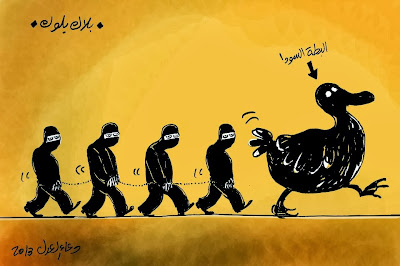The Black Duck
From what I remember about ducks in classic iconography back at uni, ducks appear in pairs as a symbol of life-long love and thus faithfulness. With faithfulness or fidelity in play we are within the terminology of power, which has rather fittingly been given the personification of a certain duck lately.
In Danish cartooning ducks have their own storyline of peaceful beings not quite adapted to modern times, as drawn by Jørn Villumsen. He constantly puts mother duck and her ducklings into new shocking situations and we eagerly follow what is happening to them every day in the paper Politiken.
As it turns out, even Jørn Villumsen's drawings of al-Assad fits very much into his main storyline. The mail accounts of the Assad-couple were hacked in February last year, revealing that her nickname for her husband was duck. From then on his symbol was a given, as drawn from Egypt by Doaa Eladl:
 |
| Doaa Eladl, Black Duck, February 1, 2013. |
So the Black Duck can be singled out on the surface of the flag to which he no longer belongs. His head breaks the outer contour. Jørn Villumsen has drawn the conflict twice with a year in between as an interpretation of the elements of the Syrian flag. The stars are the gunfire exploding while the red is bleeding into all layers - and from the roof tops into every home of the terrified citizens.
 |
| Jørn Villumsen, Syria, February 29, 2012. |
All the while the despot today is "busy":
For about half a year now this has been seen as the old flag, the one of the regime, while the protesters has put a revised version into play:
 |
| Preparations for graffiti complete with duck and spray cans, hiding from recognition behind the new version of the Syrian flag, the calligraphy is here shown with the victory sign. Nabek in Damascus. - notice the size of the stencils, the one on the right is the same design that was brought to the streets by protesting women. Photo courtesy of Tarek Alghorani. |




